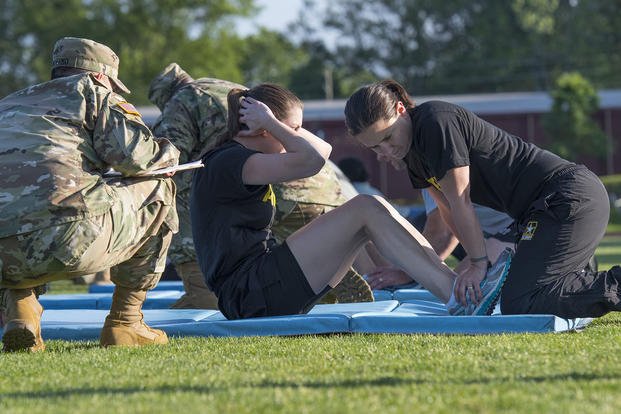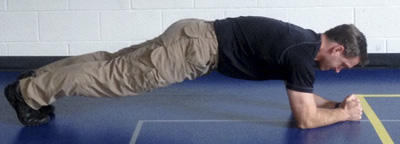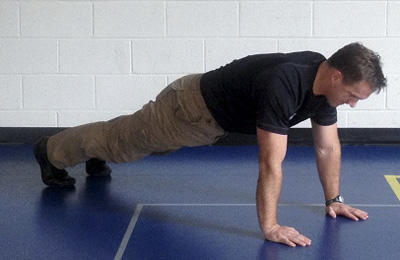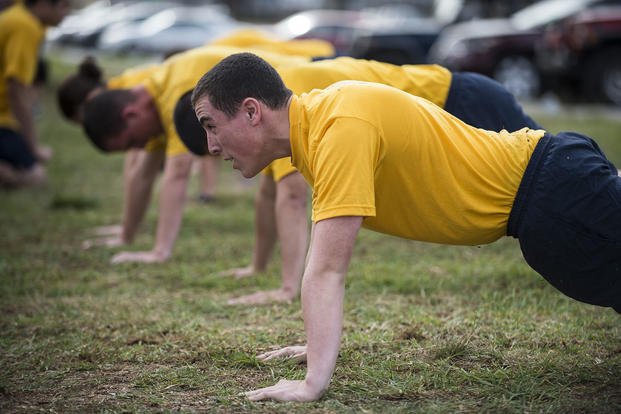Every command in the military will have people who struggle with the biannual fitness test. Many are new to this type of training and testing; some are recovering from an injury that sidelined their preparation, and others unfortunately are just not prepared and too deconditioned to pass the test.
I often get asked to help prepare all levels of fitness test takers. Recently, at a nearby Navy command, I saw several very common issues people have with failing one or more sections of the standard Navy physical readiness test (PRT):
- Push-ups
- Sit-ups
- Sit and reach
- 1.5-mile run
Here is what I observed:
Lack of Fuel, Lack of Pacing, Lack of Technique
This all started at a PT session that started at 6 a.m. Many people were running on fumes, so they were starting a workout with low blood sugar. Many people may have a drink of water before starting a fitness program, but if you are going to be pushing your limits to master a test or if it is all you can do to pass it, you need fuel. This is a broad recommendation that has several correct answers.
You have to find what works best for you. I find an orange or banana and a few sips of Gatorade or juice is enough sugar to get me through a testing fitness session. Doing max push-ups and sit-ups for two straight minutes burns a lot of sugar. Running 1.5 miles afterward at a pace that gets the heart rate higher than your normal run burns even more sugar.
This sugar is pulled from the muscles or liver in the form of glycogen. We typically have about 20-30 minutes of this high-octane fuel. If you have a high heart rate, you are anaerobic and are burning this fuel primarily. Having some form of good carbohydrates will help you during those last few minutes of the fitness test, when you have to put out to maximize your scores.
Depending on your fitness level and conditioning, this could be the difference between passing or failing the test. Even those who are conditioned enough to max the test will have reduced scores if they run out of fuel. Fuel is key.

Pacing the Sit-ups and the Run
Too many people start out way too fast on two-minute sit-up tests, as well as the first lap of a 1.5-mile run test. To fix both so you do not fall off your pace, you have to practice the events for several weeks at a goal pace.
For instance:
Problem: Many people fail sit-ups or fail to reach a competitive level because in the first 30 seconds, they can do nearly one sit-up per second. Most people who do not practice sit-ups regularly can do this for 30 seconds. The problem is that for the next 1:30 of the test, you do not match your first 30-second performance.
Answer: Start out slower. Practice a goal pace for 30 seconds, one minute and two minutes. Every thirty seconds, you should be at 25% of your goal pace. If your goal is 80 sit-ups in two minutes, work to commit the pace of 20 per every 30 seconds to muscle memory.
Tips: Do not waste your energy on going down. Staying flexed during the up and the down part of this exercise will take away those last 5-10 or more sit-ups in a two-minute test. Exert on the up movement and relax on the down, letting gravity do its job.
Add in plank poses. Also, to balance out your core, add in plank poses any time you perform sit-ups. For every minute you do sit-ups, rest in the plank position 1-2 times that long.

|
Problem: Similarly to the sit-ups, starting the first lap (quarter-mile) of your 1.5-mile timed run too fast can lead to a poorer-than-expected performance. The adrenaline of testing often is pumping, and everyone pushes too hard out of the gate. Even after hearing me say, "Keep this first lap slower than you think," people will still run 10-15 seconds faster than they should. I often see people who can barely run 1.5 miles in 12 minutes come across the first lap at a pace equivalent to someone who can run the same distance in nine minutes.
Answer: Practice your goal pace. If you take your goal pace, divide it by how many laps you must run or use the mile markers on the course, you will find your first lap pace actually can be comfortable. For instance, if you want to run 1.5 miles in 10:30, you should run at a seven-minute mile pace. That is also broken down to a 1:45 quarter-mile and a 3:30 half-mile.
Making a workout of several sets of 1:45 quarter-mile and 3:30 half-mile repeats is a great way to get faster at pacing your runs. Rest 50%-100% of the time it takes you to run that distance. You eventually will require less rest, and you will be able to maintain your goal pace for the entire 1.5-mile timed run.
Push-ups: All Practice and Hand Placement
Practice makes perfect with push-ups. Push-ups need to be done with good form (all the way up, all the way down), but proper hand placement can make a huge difference. Make sure you treat your push-ups the same as a bench press. Your hands should make a straight line across your chest.
Also, practice push-ups every other day, using various workouts as linked below.

|
Related article: PT Workouts
Depending on your PFT, there are likely dozens of issues that technique and pace can fix. Make sure you are optimizing your scores and not losing time or reps due to your lack of preparation or strategy.
Stew Smith is a former Navy SEAL and fitness author certified as a Strength and Conditioning Specialist (CSCS) with the National Strength and Conditioning Association. Visit his Fitness eBook store if you’re looking to start a workout program to create a healthy lifestyle. Send your fitness questions to stew@stewsmith.com.
Want to Learn More About Military Life?
Whether you're thinking of joining the military, looking for fitness and basic training tips, or keeping up with military life and benefits, Military.com has you covered. Subscribe to Military.com to have military news, updates and resources delivered directly to your inbox.



















